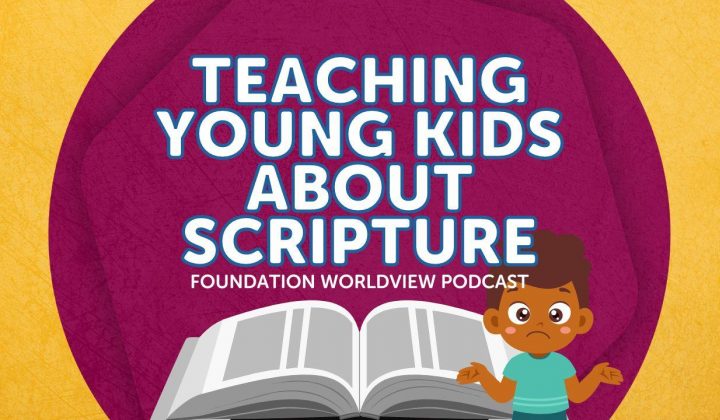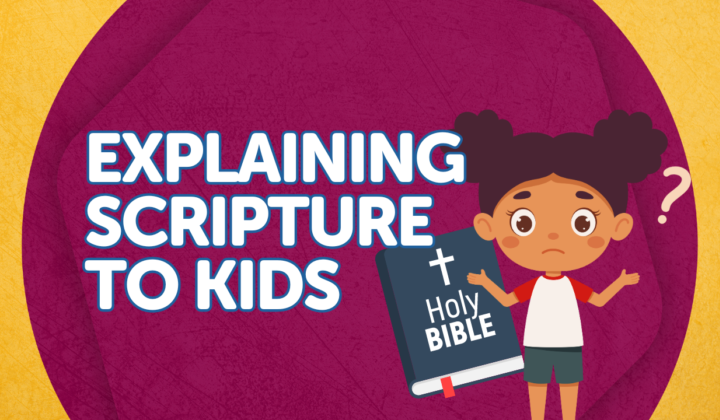Learn more about the journey that led to us equipping kids to carefully evaluate every idea they encounter.
Meet members of our team who have contributed to curriculum development.
Hear from real users of the Foundation Curriculum.
Learn what we believe about God, Jesus, Scripture, and more.
Teaching Kids Theology
How do you explain big theological words like justification, sanctification, propitiation, redemption, and reconciliation to children in a way they can understand? In this episode of the Foundation Worldview Podcast, Elizabeth Urbanowicz walks through a simple three-step approach to teaching these complex concepts to kids of all ages. You'll learn how to create easy definitions, pair them with body movements, and provide key Bible verses to help children grasp these truths.
Elizabeth also shares practical advice for pacing these teachings with younger children, emphasizing repetition, simplicity, and intentionality.
Transcript
Note: The following is an auto-transcript of the podcast recording.
Hello, friends!
Today's podcast question is such a fantastic one. It says:
"How do we explain to the children in our care, in a developmentally appropriate way, what justification, propitiation, redemption, reconciliation, and sanctification mean? Are there certain activities or body movements to explain this to sensory-seeking children?"
I absolutely love this question. It's clear that the questioner is really thinking intentionally about how to teach children—and not just teach them, but engage them in ways that help them understand.
This is so important because children learn best when their minds and bodies are actively engaged. If you’ve gone through any of the Foundation Worldview curriculums, like our Biblical Worldview curriculum, our Attributes of God curriculum, or our God’s Good Design curriculum, you’ve probably noticed this is a huge focus. We design lessons to involve movement and sensory engagement because that’s how most little ones process information best.
So, today, we’re going to dive into these big theological concepts and explore how to explain them in simple, developmentally appropriate ways to children. I’m so excited to get started.
Teaching Big Theological Terms to Little Ones
As I thought through how to answer this question, I pulled out my trusty Evangelical Dictionary of Theology to make sure I had precise definitions in mind. (Side note: during my seminary days, I used to keep that dictionary on my bed so I could grab it in the middle of the night if I woke up with a question. A friend told me it was weird, and looking back, it totally was! But, hey, it worked.)
Now, when it comes to teaching theological terms to children, I think there are three key steps:
- Provide a simple definition that young minds can grasp.
- Add a motion or action to make it memorable and fun.
- Connect it to Scripture with a key Bible verse for them to learn.
With these steps in mind, let’s look at the five terms mentioned in the question: justification, sanctification, propitiation, redemption, and reconciliation.
1. Justification
Definition: Justification means being declared right before God.
Action: You can use a judge’s gavel to demonstrate this. Have your child hold out one hand flat (as if it’s a desk) and make a fist with the other hand. Bring the fist down like a gavel while saying, “Justification: declared right before God.”
Key Verse: Romans 5:18
"Therefore, as one trespass led to condemnation for all men, so one act of righteousness leads to justification and life for all men."
Even if your child doesn’t fully understand this verse now, having them memorize it will plant seeds of understanding that will grow as they mature.
2. Sanctification
Definition: Sanctification means to be made holy.
Action: Have your child hold their hands in front of their body, palms facing themselves. Start with their hands near their head, then slowly move them down toward their waist. This motion represents the process of being made holy over time. As they do this, they can say, “Sanctification: to be made holy.”
Key Verse: 1 Thessalonians 4:3
"For this is the will of God, your sanctification."
This verse is short and simple, perfect for helping kids understand that sanctification is God’s will for their lives.
3. Propitiation
Definition: Propitiation means turning away wrath through an offering.
Action: Teach your children to hold their hands out in front of them, palms up, as if they’re holding an offering. Then have them lift their hands and gaze upward. As they do this, they can say, “Propitiation: turning away wrath through an offering.”
Key Verse: 1 John 4:10
"In this is love, not that we have loved God but that he loved us and sent his Son to be the propitiation for our sins."
What a beautiful truth to teach our children—that Jesus turned away God’s wrath on our behalf.
4. Redemption
Definition: Redemption means being saved through the payment of a ransom.
Action: Have your children cross their wrists in front of them, as if their hands are in chains. Then have them “break” the chains by pulling their hands apart. As they do this, they can say, “Redemption: being saved through the payment of a ransom.”
Key Verse: Colossians 1:13–14
"He has delivered us from the domain of darkness and transferred us to the kingdom of his beloved Son, in whom we have redemption, the forgiveness of sins."
This verse gives such a clear picture of how God rescues us from darkness and brings us into His light.
5. Reconciliation
Definition: Reconciliation means overcoming division by being united.
Action: Start with your hands apart, as if separated. Then bring them together into a handshake. As you do this, say, “Reconciliation: overcoming division by being united.”
Key Verse: 2 Corinthians 5:19
"In Christ, God was reconciling the world to himself, not counting their trespasses against them, and entrusting to us the message of reconciliation."
This verse reminds us of the beautiful work God has done to bring us back into relationship with Him and how we’re called to share that message with others.
Making It Practical
If you’re teaching these terms to younger children (especially those under eight), take it slow. Spend a week—or even a whole month—on just one word. For example:
- In January, focus on justification. Practice the definition, do the hand motion, and memorize Romans 5:18.
- In February, move on to sanctification.
Repetition and consistency are key to helping little ones internalize these truths.
Encouragement for Parents and Caregivers
If you’re feeling unsure about teaching these big concepts, take heart—you don’t need to have it all figured out. It just takes practice, intentionality, and time.
If you’re looking for additional resources to help teach biblical truths to your children, I highly recommend checking out our Foundation Worldview curriculums. While we don’t have a curriculum that specifically covers these five terms, our programs—like our Biblical Worldview curriculum, Attributes of God curriculum, and God’s Good Design curriculum—use the same method of combining simple definitions, key Scriptures, and engaging activities to help children think critically and biblically.
I hope it has been helpful as you think through how to teach these big theological terms to the children in your care.
Related Posts and insights

Teaching Young Kids About Scripture
Join host Elizabeth Urbanowicz in this episode of the Foundation Worldview Podcast as she addresses the question: how to help younger kids, seven and under, understand passages of scripture. Through examples and strategies, Elizabeth explores how to guide children in developing a firm understanding of the biblical worldview.

Explaining Scripture to Kids
Today's question says, "John 15:14 says, we are Jesus's friends if we do what he commands, since that's not how human friendships work, that we're only friends if you do everything I say, how do I explain this to my child?"

How to Study the Bible for Kids and Parents - A Starter’s Guide for Home Discipleship
We need to teach our kids how to fish so they can read, interpret and apply the Bible for themselves.



